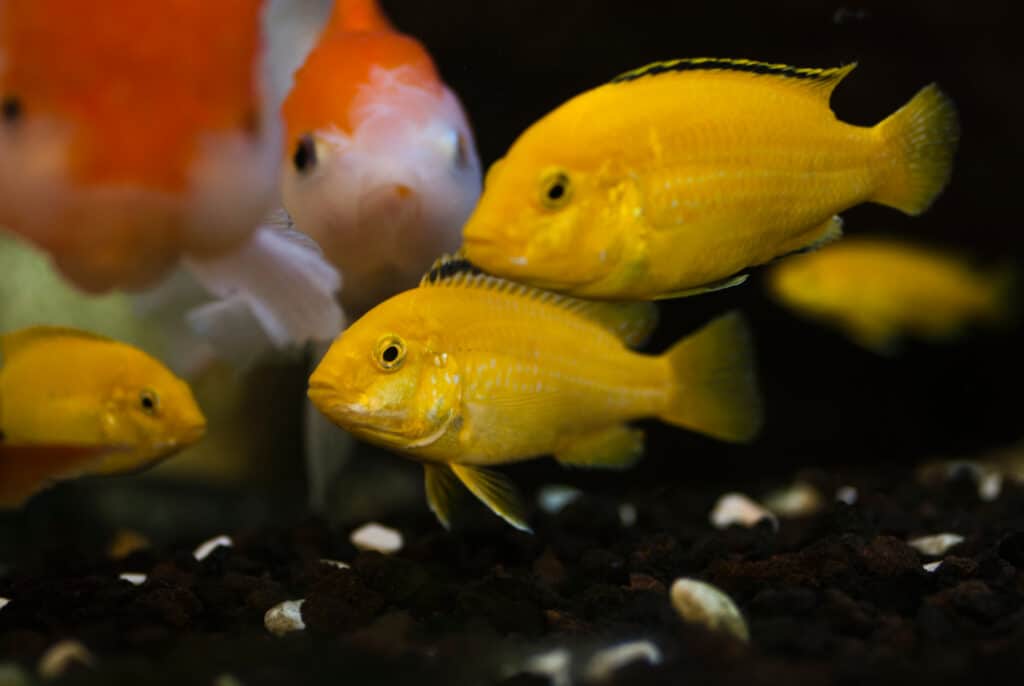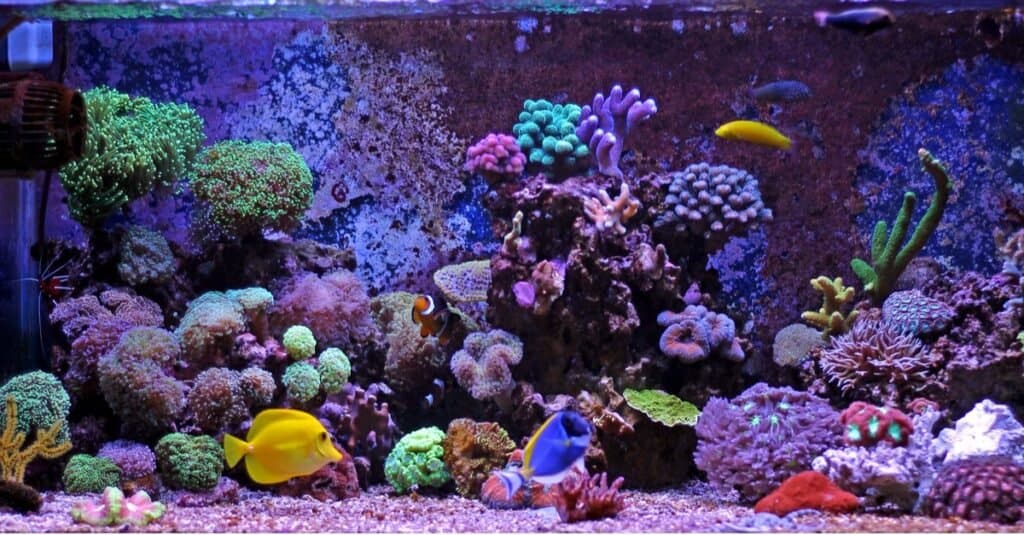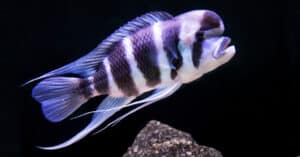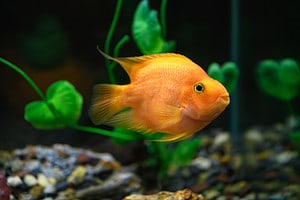For an easy beginner pet fish with a striking appearance, look no further than the yellow lab cichlid! Its stunning bright yellow coloration combined with a relatively easygoing temperament make it a popular choice for aquarium enthusiasts. But what’s the difference between the males and females of this species, and does it matter? Compare the male vs. female yellow lab cichlid to find out!
Comparing a Male vs Female Yellow Lab Cichlid
The yellow lab cichlid is a species of freshwater fish belonging to the family Cichlidae. Its scientific name is Labidochromis caeruleus.
| Male Yellow Lab Cichlid | Female Yellow Lab Cichlid | |
|---|---|---|
| Size | 4-5 inches, 0.75 ounces | 2-3 inches, 0.75 ounces |
| Appearance | Elongated, stocky body; black stripe on dorsal fin; black anal and ventral fins; light spots on fins | Elongated, stocky body; black stripe on dorsal fin |
| Color | Bright yellow, blue, albino yellow, white Generally more vibrant than females | Bright yellow, blue, albino yellow, white Generally duller than males |
| Reproduction | Initiates mating rituals, fertilizes eggs | Lays eggs, carries eggs in her mouth until they hatch |
| Behavior | Semi-aggressive | Semi-aggressive |
The 5 Key Differences Between a Male and a Female Yellow Lab Cichlid
Yellow lab cichlids are sexually dimorphic, though some of the differences are subtle. Below you will find the five key differences between male and female yellow lab cichlids including size, appearance, color, reproduction, and behavior.
Size

Electric yellow cichlids are a naturally occurring variation of
Labidochromis caeruleus.
©Mircea Costina/Shutterstock.com
Male yellow lab cichlids are significantly larger than females; the species, however, is one of the smallest in the cichlid family. Males can grow up to 4-5 inches in length, though 5-inch specimens are usually only found in well-kept aquarium environments. Females usually only grow to 2-3 inches in length. The average weight for this species is 0.75 ounces.
Appearance
Apart from sheer size, male and female yellow lab cichlids are hard to tell apart just by body type. Both sexes have elongated, stocky bodies with a black stripe along the dorsal fin. However, males may also have black anal and ventral fins, while this never occurs in females. Males also occasionally have light spots on their fins.
Color
Yellow lab cichlids derive their name from their stunning yellow color. Other names for this species include the electric yellow lab, lemon yellow lab, and lemon drop cichlid. Of course, yellow is not the only possible “morph” (color type). Both males and females of this species can also be albino yellow, blue, and white. As with most species of fish, the males are typically brighter and more vibrant than the females.
Reproduction
Yellow lab cichlids reproduce easily and do not usually need humans to encourage them. By six months of age, they should reach about 1.5 inches in length and should be ready to begin reproducing.
After digging a pit or staking out a flat rock, the male performs a mating dance of sorts to attract a female. She then lays between 10-30 eggs and takes them into her mouth where the male fertilizes them. The female carries the eggs around for about three weeks until they hatch and the fry are ready to swim on their own. While she has the eggs in her mouth, she will eat nothing, fasting for as long as 25-40 days.
Behavior

Yellow cichlids (pictured here with an oranda goldfish) are nonaggressive compared to many other cichlid varieties.
©Rani Restu Irianti/Shutterstock.com
Yellow lab cichlids are one of the most nonaggressive Mbuna species. They are semi-aggressive in a tank environment compared to some species from other families, though ample space and plants to block visual contact will reduce territorial behavior. Males may become fiercer when looking for mates while females will become protective while carrying eggs.
Habitat
Yellow lab cichlids originate in Lake Malawi in East Africa. They live mostly in the central western coastal region of the lake’s Nkhata Bay. This species is one of more than two hundred Mbuna species (African cichlids from Lake Malawi). Though they are freshwater fish, they can also survive in brackish conditions.
Lifespan
Yellow lab cichlids live between six to 10 years in captivity, though rare individuals have been known to live slightly longer. This is a lengthy lifespan for a freshwater fish, representing a long-term commitment on the part of the pet owner.
Yellow lab cichlids are susceptible to a number of diseases, most of which are common to other types of fish. Malawi bloat is the most common affliction for this particular species. It stems from a dietary lack of vegetable proteins and fibers. Because yellow lab cichlids are omnivorous, it is vital for them to get plant as well as animal matter. Malawi bloat causes bloating and occasionally skin sores.
Ich, or white spot disease, is another common affliction. This skin condition causes white spots to appear on the head, gills, and body. Parasites attack weak and unhealthy fish to cause ich to develop. Yellow lab cichlids may also suffer from hole in the head disease, also the result of parasites. This condition causes lesions or pits on the head and lateral line.

Yellow lab cichlids need at least a 30-gallon aquarium, though some recommend a 40-50 gallon tank.
©iStock.com/vojce
Pet Care
Both male and female yellow lab cichlids are easy to care for and mostly nonaggressive in temperament. This makes them excellent beginner pets, though it is imperative that all fish owners thoroughly research potential pets before purchase. The most basic of all requirements is the size of the tank. Yellow lab cichlids do best with a tank no smaller than 30 gallons, though some experts advise a 40-50 gallon tank. If the owner chooses to keep more than one or two of these fish together in the same environment, a larger tank is advisable. Not only will this satisfy the fish’s physical needs, but it will also prevent unnecessary aggression.
Correct water conditions are also vital to the health of the fish. The ideal water temperature for this species is 72-82°F. The water pH shouldn’t stray outside 7.2–8.8 while the water hardness should remain between 10-20 dH.
The lighting in the tank should be kept low to mimic conditions in Lake Malawi. Plants, rocks, and driftwood are all welcome aquarium decorations, not only for their aesthetic value but also to give the fish places to hide. Yellow lab cichlids are not overly aggressive fish, but any fish can become territorial with too many other fish around and no place to escape. Ideal tank mates for this species include convict cichlids, peacock cichlids, and tiger oscar cichlids.
Yellow lab cichlids need a diet split equally between plant and animal matter. Fish flakes as well as fresh or frozen fish food provide a good nutritional foundation. Experts don’t recommend feeding this species live food as it may result in injury. Instead, food sources like shrimp and bloodworms should already be dead before entering the tank.
If given the right amount of space and the right tank mates, male and female yellow lab cichlids make great pets both for beginners and those with lots of experience.
Up Next
- Pet Fish Guide: What You Need To Know
- The 6 Most Expensive Pet Fish to Insure and Why
- 12 Types of Blue Fish: Different Aquarium Fish that are Blue
The photo featured at the top of this post is © Theatrus / Creative Commons / Original
Thank you for reading! Have some feedback for us? Contact the AZ Animals editorial team.






